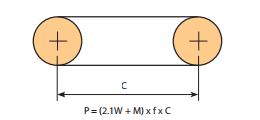Introduction
A mindful assessment on the situations surrounding a conveyor is important for accurate conveyor chain variety. This part discusses the basic considerations required for prosperous conveyor chain variety. Roller Chains are frequently utilised for light to reasonable duty material dealing with applications. Environmental problems may perhaps need the usage of exclusive resources, platings coatings, lubricants or even the capacity to operate without the need of added external lubrication.
Basic Information Expected For Chain Choice
? Type of chain conveyor (unit or bulk) together with the system of conveyance (attachments, buckets, by way of rods and so forth).
? Conveyor layout together with sprocket spots, inclines (if any) along with the quantity of chain strands (N) to become made use of.
? Amount of material (M in lbs/ft or kN/m) and sort of materials to become conveyed.
? Estimated fat of conveyor components (W in lbs/ft or kN/m) which include chain, slats or attachments (if any).
? Linear chain velocity (S in ft/min or m/min).
? Environment during which the chain will operate like temperature, corrosion circumstance, lubrication issue and so forth.
Phase 1: Estimate Chain Stress
Use the formula below to estimate the conveyor Pull (Pest) and then the chain tension (Check). Pest = (M + W) x f x SF and
Check = Pest / N
f = Coefficient of Friction
SF = Speed Factor
Stage two: Create a Tentative Chain Selection
Utilizing the Check value, create a tentative variety by picking a chain
whose rated working load better compared to the calculated Check worth.These values are acceptable for conveyor services and therefore are diff erent from these proven in tables on the front with the catalog that are linked to slow velocity drive chain usage.
Also to suffi cient load carrying capacity often these chains must be of the particular pitch to accommodate a desired attachment spacing. Such as if slats are to be bolted  to an attachment each one.five inches, the pitch with the chain chosen will have to divide into 1.5?¡À. As a result one particular could use a forty chain (1/2?¡À pitch) together with the attachments every single 3rd, a 60 chain (3/4?¡À pitch) with all the attachments each 2nd, a 120 chain (1-1/2?¡À pitch) together with the attachments just about every pitch or maybe a C2060H chain (1-1/2?¡À pitch) with the attachments every pitch.
to an attachment each one.five inches, the pitch with the chain chosen will have to divide into 1.5?¡À. As a result one particular could use a forty chain (1/2?¡À pitch) together with the attachments every single 3rd, a 60 chain (3/4?¡À pitch) with all the attachments each 2nd, a 120 chain (1-1/2?¡À pitch) together with the attachments just about every pitch or maybe a C2060H chain (1-1/2?¡À pitch) with the attachments every pitch.
Stage three: Finalize Choice – Determine Actual Conveyor Pull
Immediately after generating a tentative selection we need to verify it by calculating
the real chain stress (T). To try and do this we need to fi rst determine the real conveyor pull (P). In the layouts proven about the proper side of this page select the suitable formula and calculate the total conveyor pull. Note that some conveyors may be a blend of horizontal, inclined and vertical . . . in that case determine the conveyor Pull at just about every part and add them together.
Step 4: Determine Greatest Chain Stress
The maximum Chain Tension (T) equals the Conveyor Pull (P) as calculated in Step three divided by the number of strands carrying the load (N), occasions the Pace Factor (SF) shown in Table 2, the Multi-Strand Issue (MSF) shown in Table three plus the Temperature Aspect (TF) proven in Table 4.
T = (P / N) x MSF x SF x TF
Phase 5: Examine the ?¡ãRated Working Load?¡À from the Selected Chain
The ?¡ãRated Operating Load?¡À in the picked chain ought to be better compared to the Highest Chain Stress (T) calculated in Step 4 over. These values are proper for conveyor support and are diff erent from those proven in tables on the front from the catalog that are linked to slow velocity drive chain utilization.
Stage six: Examine the ?¡ãAllowable Roller Load?¡À on the Chosen Chain
For chains that roll on the chain rollers or on leading roller attachments it’s important to check the Allowable Roller Load?¡À.
Note: the Roller load is determined by:
Roller Load = Wr / Nr
Wr = The total bodyweight carried from the rollers
Nr = The amount of rollers supporting the fat.